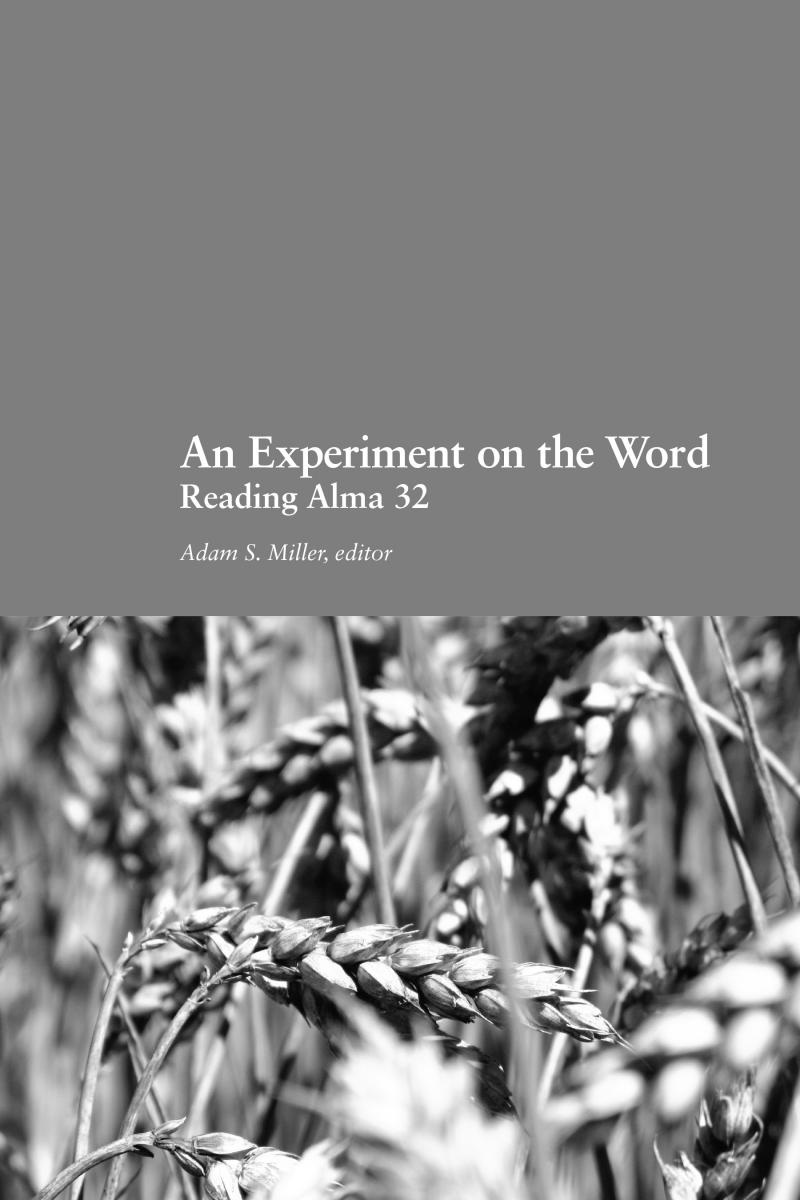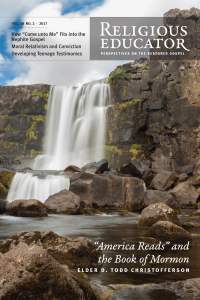Review of An Experiment on the Word
Nicholas J. Frederick
Nicholas J. Frederick, "Review of An Experiment on the Word," Religious Educator 18, no. 2 (2017): 168–72.
Nicholas J. Frederick (nick_frederick@byu.edu) was an assistant professor of ancient scripture at BYU when this article was published.
 Adam S. Miller, editor. An Experiment on the Word: Reading Alma 32. Provo, UT: Neal A. Maxwell Institute for Religious Scholarship, 2014. Bibliography, 110 pages. ISBN-13: 978-0842528702, U.S. $18.95.
Adam S. Miller, editor. An Experiment on the Word: Reading Alma 32. Provo, UT: Neal A. Maxwell Institute for Religious Scholarship, 2014. Bibliography, 110 pages. ISBN-13: 978-0842528702, U.S. $18.95.
In this remarkable little volume, a small group of Mormon scholars who form what they call the “Mormon Theology Seminar” perform an experiment on the Book of Mormon. They ask two questions: First, what would happen if the Book of Mormon were read theologically, instead of historically or doctrinally? Second, what would happen if this theological reading were done in a collaborative setting? Fittingly, they selected Alma 32 as the text to be experimented on, with the six essays in this small work (about 100 pages) as the result. The contributors, drawing upon backgrounds in philosophy, literature, biblical studies, and finance, attempt to provide answers to four overarching questions: (1) “What does Alma 32 teach us about exercising faith?” (2) “What does Alma mean by ‘the word,’ and why is it so central to faith?” (3) “What is meant by ‘experiment’ in Alma 32:27?” and (4) “How might paying close attention to the textual, historical, and political contexts of Alma 32 shape or reshape our understanding of Alma’s treatment of faith?”
The first essay, “Desiring to Believe: Wisdom and Political Power,” by James E. Faulconer, begins with the assumption that Alma 32 is best understood within the context of the original Book of Mormon chapter breaks, in this case Alma 30:1–35:16. Beginning with Korihor and ending with the expulsion of the believing Zoramites, Faulconer isolates a particular thread, namely desire, with Alma 32 as “the apex of the story’s arc” (23). Faulconer then explores how Alma masterfully takes the desire of the Zoramite poor for political power and instead argues that their desire ought to be for the “word.”
The second essay, “You Must Needs Say That the Word Is Good,” by volume editor Adam S. Miller, focuses on Alma’s discussion of the relationship between faith and humility, a relationship which Miller summarizes as “faith is humility without compulsion” (35). One of the more fascinating turns this article takes comes from Miller’s exploring the implications of the phrase “his word” in 32:22. Miller’s belief is that “the weight of the possessive pronoun shifts the primary sense of the phrase away from the abstract register of doctrine and toward the concrete register of a personal promise so that we might read ‘God’s word’ as primarily having the sense of ‘giving one’s word’” (36).
The fourth essay, “Faith, Hope and Charity: Alma and Joseph Smith,” by Joseph M. Spencer, raises two very interesting questions. First, Spencer notes that of the theological triad of faith, hope, and charity, only faith and hope are mentioned in Alma 32:21–23. This leads Spencer to wonder why charity is absent. Spencer finds his answer in verse 23: “And now, he imparteth his word by angels unto men, yea, not only men but women also. Now this is not all; little children do have words given unto them many times, which confound the wise and the learned.” The mentioning of “angels” leads Spencer to Alma 12–13 in which Alma discussed the reception of angels by Adam and Eve, the earliest patriarch and matriarch. Spencer’s conclusion is that “charity” can be found in the familial covenant that he sees as being alluded to in Alma 32: “Angels come as messengers of the patriarchal/
In the final essay, “Faith and Commodification” by Robert Couch, Couch uses his background and training in finance to identify a particular tension he sees in Alma 32 and which he illustrates through a modern comparison of fruit growth and consumption. On one hand, Couch says, there are those who choose to invest time, resources, and effort into the lengthy process of growing their own fruit, and their reward is one of “delight and deep satisfaction” (87). On the other hand, there are those consumers who simply go to the supermarket and pick out whatever fruit they want, an endeavor that costs less in both time and money. Couch’s point is that consumers, largely concerned with the end product, are similar to those who seek after signs: “Sign-seekers, effectively, do not care about the process of knowledge production; rather, they want knowledge as cheaply and conveniently as possible” (89). The message Alma is trying to teach the Zoramite poor is that true knowledge can be gained only through participating in a lengthy, time-consuming process of humility, finding a place for the seed, and continuing to nourish it. While that knowledge may not come as quickly as it would if we were to see a “sign,” the end result is much more fulfilling, as we receive “a precious gift that can be gratefully received, deeply enjoyed, and faithfully cherished” (98).
The two standout essays, in my opinion, are the contributions of Jenny Webb and Julie M. Smith. Webb’s essay, “It Is Well That Ye Are Cast Out: Alma 32 and Eden,” argues that the encounter with the Zoramites has been framed around thematic connections to the story of Adam and Eve. Both Adam, Eve, and the Zoramite poor were all cut off, they were all driven out from their religious center, and were all in need of knowledge. Webb argues that three themes present in both accounts are meant to link them together: The Fall, the tree, and the presence of a messenger. Webb doesn’t say whether she believes Alma consciously noted these thematic connections or if Mormon edited the account in a way that brought them to the surface, but she does make a good argument that the connections are, in fact, present.
Smith’s essay, “So Shall My Word Be: Reading Alma 32 through Isaiah 55,” uses intertextuality to explore the deliberate (in Smith’s opinion) dependence of Alma 32 upon Isaiah 55 in the development of key themes. For example, Smith sees parallels between the use of “labor” in Isaiah 55:2 and the complaint of the Zoramite poor that they have been cast out of a synagogue which they “have labored abundantly to build with [their] own hands” (32:5). Smith teases out some interesting connections, concluding that “the Alma text makes clear that they need to repent; the Isaiah text may give us a window into why they need to repent” (77). The value of Webb’s and Smith’s essays is not just that both authors view the Alma 32 narrative as part of a larger biblical story, but rather the demonstration that a careful, close reading of both the Bible and the Book of Mormon is required to fully draw these connections out. Simply looking for broad themes or clusters of similar words is inadequate.
I suppose I could be nitpicky and point out the lack of a scripture index or subject index in this volume (although there is a brief bibliography), but the volume is so narrowly focused that those may not be of much help anyway. Overall, this is a fine contribution to Book of Mormon studies that demonstrates the value of bringing to the foreground the text of the book itself in a collaborative setting.
